| Lesson 6 | The Advertising model |
| Objective | Identify the various Advertising Models. |
B2B Advertising Models
Like Brokerage models, Advertising models can be applied to both B2B and B2C businesses, although some are better suited to one or the other. The Advertising model in eBusiness mirrors the advertising techniques and to some extent the mediums applied to traditional media, such as print, radio, and television. eBusiness uses internet technologies as the medium to link sellers and buyers.
Advertisements are placed in or around Web site content, and complimentary services such as email or free Web space are offered in order to attract an audience. This model relies on high volumes of visitors to both interest advertisers and to obtain revenue.
There are various derivatives of the Advertising model:
Advertisements are placed in or around Web site content, and complimentary services such as email or free Web space are offered in order to attract an audience. This model relies on high volumes of visitors to both interest advertisers and to obtain revenue.
There are various derivatives of the Advertising model:
Portals
Portals are of increasing popularity in both B2B and B2C situations. They can be similar to directories but do not necessarily charge advertisers for listings or referrals. Portals have many different methods of attracting traffic, and can be grouped into the following types, as described in the diagram below:
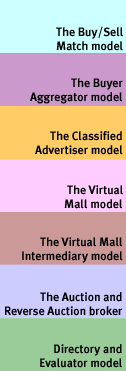
- Buy/Sell Match model , 2) Buyer Aggregator Model, 3) Classified Advertiser Model, 4) Virtual Mall Model, 5) Virtual Mall Intermediary Model, 6) Auction and Reverse Auction broker, 7) Directory and Evalutor Model
- An example of a B2C Buyer Aggregator model broker might be a business that does bulk buying of electronic appliances and resells to the public
- B2C classified advertiser model broker might be a company that provides a service that lists classified ads for cars, furniture, housing, and jobs.
- Example might be a company that hosts other online retailers much like traditional shopping malls or shopping centers.
- Shipping agent or credit financing company may set-up and run a site that sells products from companies who use their services. The shipping agent takes orders, processes payments, and then organizes the logistics of supplying the product to the buyer
- The online auction process allows millions of users access to auctions worldwide. The reverse auction might sell airline tickets or hotel accomodation to travelers, where the hotel or airline opts to accept or reject the price offered.
- For example, a B2C evaluator broker may be a company that rates household services based on customer feedback. The user could go to the site to get a recommendation for a reputable plumber in his or her area.
Various Types of Advertising Models
The basic categories of business models discussed below include:
- Advertising: The web advertising model is an extension of the traditional media broadcast model. The broadcaster is represented by a web site and provides content and services mixed with contextual advertisement in the form of Adsense or Google Ad Exchange. The Ads may be the major or sole source of revenue for the broadcaster. The broadcaster may be a content creator or a marketer implementing content marketing. The advertising model works best when the volume of viewer traffic is large or highly specialized.
- Affiliate: In contrast to the generalized portal, the affiliate model provides purchase opportunities wherever people may be browsing the web. It does this by offering financial incentives (in the form of a percentage of revenue) to affiliated partner sites as in the case of Amazon. The affiliates provide purchase-point click-through to the merchant. It is a pay-for-performance model in that, if an affiliate does not generate sales, it represents no cost to the merchant. The affiliate model is inherently well-suited to the web. Variations include, banner exchange, pay-per-click, and revenue sharing programs. [Amazon.com]
- Brokerage: Brokers are market-makers and they bring buyers and sellers together and facilitate transactions. Brokers play a frequent role in (B2B)business-to-business, (B2C)business-to-consumer , or (C2C) consumer-to-consumer markets. Usually a broker charges a fee or commission for each transaction it enables.
- Community: The viability of the community model is based on user loyalty. Users have a high investment in both time and emotion. Revenue can be based on the sale of ancillary products and services or voluntary contributions. Revenue may be tied to contextual advertising and subscriptions for premium services. The Internet is inherently suited to community business models and today this is one of the more fertile areas of development, as seen in rise of social networking.
- Infomediary: Data about consumers and their consumption habits are valuable, especially when that information is carefully analyzed and used to target marketing campaigns. Independently collected data about producers and their products are useful to consumers when considering a purchase. Some firms function as infomediaries (information intermediaries) assisting buyers and/or sellers understand a given market.
- Manufacturer (Direct): The manufacturer or "direct model", it is predicated on the power of the web to allow a manufacturer (i.e., a company that creates a product or service) to reach buyers directly and thereby compress the distribution channel. The manufacturer model can be based on efficiency, improved customer service, and a better understanding of customer preferences. [Dell Computer]
- Merchant: Wholesalers and retailers of goods and services. Sales may be made based on list prices or through auction.
- Subscription: Users are charged for a specific period: 1)daily, 2) monthly or 3) annual fee to subscribe to a service. It is not uncommon for sites to combine free content with "premium" content. Subscription fees are incurred irrespective of actual usage rates. Subscription and advertising models are frequently combined.
- Utility: The utility or on-demand model is based on metering usage, or a "pay as you go" approach. Unlike subscriber services, metered services are based on actual usage rates. Traditionally, metering has been used for essential services. Internet service providers (ISPs) in some parts of the world operate as utilities, charging customers for connection minutes, as opposed to the subscriber model common in the U.S.

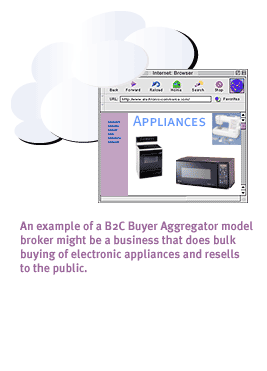
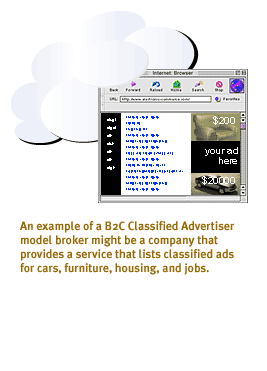
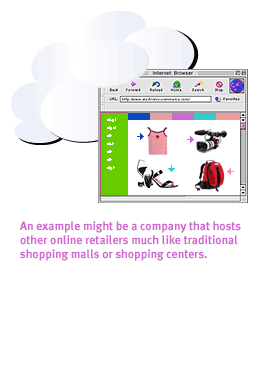
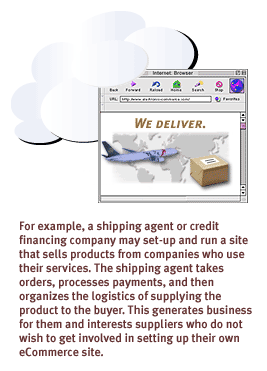
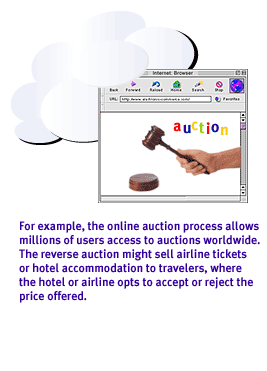
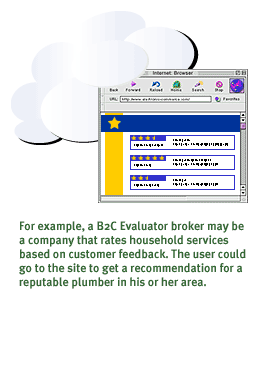
The Personalized Portal and Privacy
Allowing visitors to customize the site based on their interests and requirements makes for a richer user experience, but building a company's eBusiness model on a technology that depends on turning
personalized information into sales, is no small risk.
As you will see throughout this course, it is the architect's responsibility to consider the handling of sensitive information very seriously, and to safeguard sensitive personal data using secure firewalls, copyrights, and monitoring liability in cooperation with diligent legal counsel. How important are the privacy rights of individuals? Personalized information suggests a richer user experience, and yet the question of how to collect data and use it to boost the bottom line is often ahead of privacy concerns. The next lesson completes the module.
As you will see throughout this course, it is the architect's responsibility to consider the handling of sensitive information very seriously, and to safeguard sensitive personal data using secure firewalls, copyrights, and monitoring liability in cooperation with diligent legal counsel. How important are the privacy rights of individuals? Personalized information suggests a richer user experience, and yet the question of how to collect data and use it to boost the bottom line is often ahead of privacy concerns. The next lesson completes the module.
Advertising - Exercise
Click the Exercise link below to complete an exercise on the Advertising model.
Advertising - Exercise
Advertising - Exercise